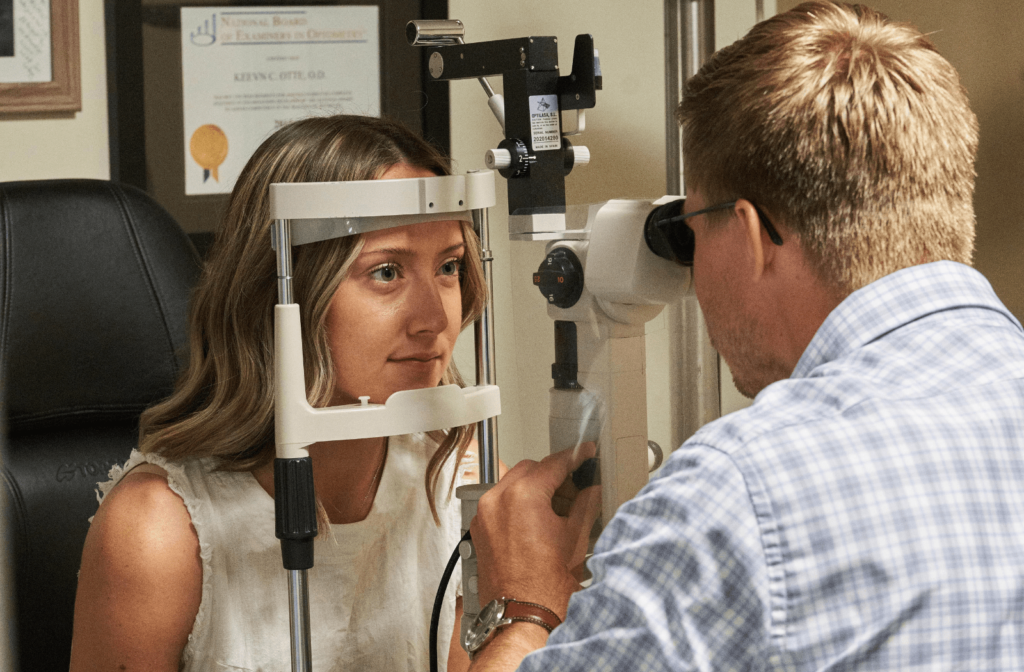When was your last comprehensive eye exam? You might think your vision is fine, but eye exams can catch a lot more than just vision problems.
An optometrist will test your eyesight and your glasses prescription during a test known as a Refraction as part of a comprehensive eye examination. However, they will also perform several additional tests to assess the eye anatomy that may find health issues you are unaware of.
Because of their delicate structures, including nerves, blood vessels, and connective tissues, the eyes can show early warning signs of a variety of serious health problems. This can be critical for patients because detecting diseases early is often the key to avoiding serious consequences.
Health Risks That Eye Exams Can Detect
The advantages of annual visits to your optometrist extend far beyond keeping your eyes in good working order.
A close examination of the lens, retina and optic nerve can reveal a variety of systemic disorders, including high blood pressure, diabetes, cancer, and more, sometimes before other symptoms appear.
High Blood Pressure
An Optometrist may be able to tell you if you have high blood pressure while examining your eyes. It frequently causes kinks and other problems with the blood vessels in the back of a person’s eye.
If you have high blood pressure, it can cause a variety of eye problems. Glaucoma is one of the most serious eye conditions that can occur as a result of high blood pressure.
Diabetes
Diabetic retinopathy can be identified by tiny blood vessels in the retina that leak yellow fluid or blood. This disease can appear in eye tissue even before a person is diagnosed with diabetes. People who are diagnosed early can avoid permanent vision loss and other serious complications.
Heart Disease
Early signs of heart disease in the eyes may be detectable by optometrists. Your eye doctor may be able to detect microscopic marks left by an eye stroke if the retina is carefully examined using an imaging tool called an optical coherence tomographer (OCT). These marks can appear in healthy people’s retinas, however, there are more marks in people with heart disease.
Cancer
Many types of cancer can be detected with a comprehensive eye exam. Some common forms of ocular cancer include:
- Blood Melanoma
- Skin Retinoblastoma
- Tissue Metastatic Breast Cancer
- Lymphoma
- Basal Cell Carcinoma
Your Optometrist may be able to assist you in the detection process. Each of these types of cancer will frequently show symptoms that can be detected during a thorough eye exam. And if cancer is detected your Optometrist can make an urgent referral to an ocular oncologist when necessary.
Lupus
If your eyes are consistently dry, you could have dry eye disease. You could, however, be suffering from lupus, an inflammatory disease. It’s an autoimmune disease that causes your body to attack healthy tissues.
If an optometrist notices swelling in the white part of your eyes during an exam, they may be concerned about lupus.
Multiple Sclerosis
Multiple sclerosis, a degenerative disease of the nervous system, can be accompanied by optic nerve inflammation. This inflammation is frequently associated with severe blurred vision, painful eye movement, or even double vision.
Stroke
Retinal blood vessels can develop blockages or clots. These obstructions can cause blind spots or the sensation of a “curtain” closing over a person’s vision. These may indicate an increased risk of stroke.
Rheumatoid Arthritis
Rheumatoid arthritis (RA) is one of the most agonizing types of arthritis. It can cause your body to target healthy tissues in your body, similar to lupus. As a result, you’ll have a lot of inflammation in your joints and other areas.
When you have RA, you may be surprised at how much your eyes can hurt. The redness of your eyes can indicate to an optometrist that you have RA. They can also detect it if there is any inflammation in the white parts of your eyes.
Thyroid Disease
If your eyes are bulging or protruding from eyelids that appear to be retracting, your optometrist will suspect hyperthyroidism, which is frequently caused by Grave’s Disease. The tissues and muscles around the eye are affected by this condition, and symptoms may include blurry vision, vision loss, or dry eyes.
Brain Tumors
Your optometrist can see the impact of a brain tumour in the back of your eye when it forms and causes swelling and increased pressure in the brain. Your eye doctor may be able to detect pressure on the optic nerve.
As a patient, you may experience double vision, a loss of peripheral vision, or a change in pupil size, sometimes on only one side.
Book Your Comprehensive Eye Exam
It’s important to know that some of these symptoms do not indicate that you definitely have a specific health condition. When an eye exam reveals a potential health problem, your ophthalmologist will advise you to seek additional testing from a specialist or your primary care provider.
Book your comprehensive eye exam at Orchard Park Optometry today to get a full look at your vision and health.




